 All Our Tours
All Our Tours
Written by: Vicky Nguyen
Updated date:03/05/2025
Hello, I’m Vicky! As a passionate travel enthusiast and tour planner at Asia Viva Travel, I’ve gathered extensive experience traveling across Vietnam and other captivating destinations in Southeast Asia. Now, I’m thrilled to share these adventures with you through my blog. From my journeys, I’ve gained a deep understanding of the unique cultures, hidden gems, and unforgettable experiences that this region has to offer. My goal is to bring you authentic and practical insights to help you design your own remarkable adventures. Join me, and let’s discover these extraordinary places together!
Contents
Nestled at the foot of the misty mountains in Champasak Province, Wat Phu is a timeless jewel of Southern Laos. Overlooking the vast Mekong River and part of the ancient cultural landscape of the Si Phan Don archipelago, this sacred Khmer temple complex traces its roots back to the 5th century – long before the glory of Angkor Wat. Revered as Laos’s spiritual counterpart to Angkor, Wat Phu exudes a quiet majesty that speaks to centuries of devotion, mythology, and architectural brilliance.
Lying gracefully at the base of Phou Khao Mountain, in the heart of Champasak Province, Laos, just 6 kilometers from the Mekong River, Wat Phou is an ancient Khmer Hindu temple complex, also called “ mini Angkor Wat” of Laos. with its blend of history, spirituality, and architecture. As visitors arrive, they are immediately embraced by the vast, tranquil grounds, where towering, leafy trees cast cool shadows over stone pathways. Right at the entrance, a small museum houses over 100 stone statues, intricate reliefs, and beautifully preserved carvings – offering a vivid glimpse into the temple’s sacred past.
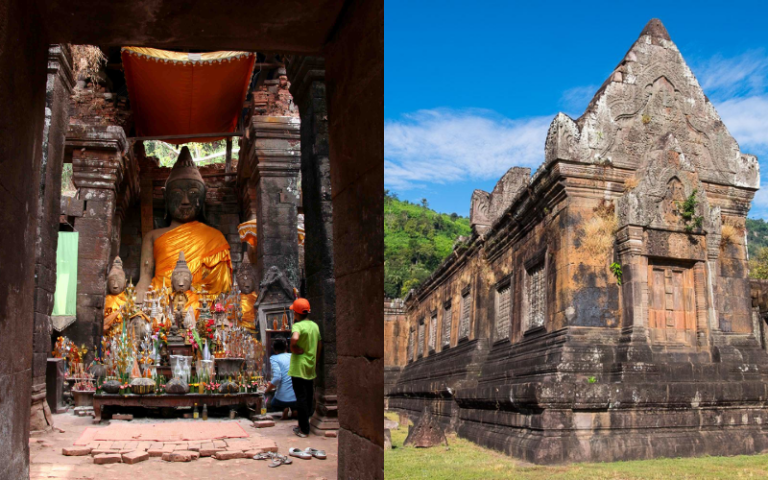
Stone and spirit rise as one in timeless harmony
Following the central path, one can catch sight of the upper temple from afar-an awe-inspiring structure built entirely from stone, each block meticulously shaped and fitted with precision. Carved with elaborate motifs in classic Khmer style, the upper sanctuary rises against a dramatic cliffside, enhancing the majesty of this sacred space.
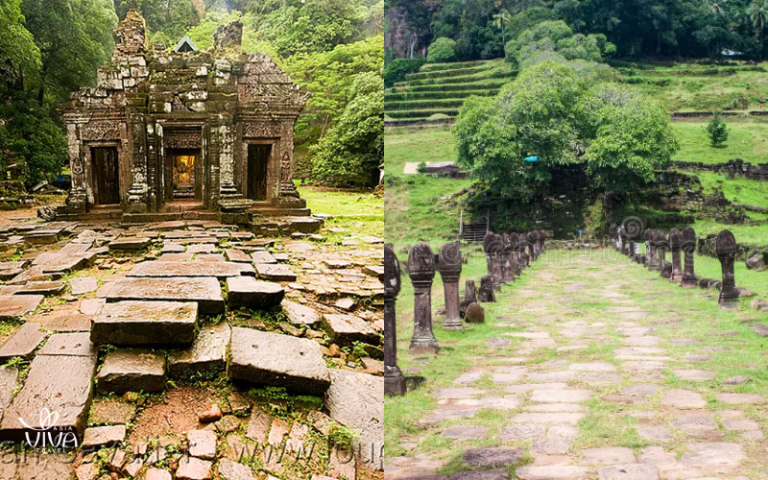
A quiet path through history, beneath sacred shade
What makes Wat Phou truly remarkable, however, is its seamless spiritual transformation over the centuries. Originally constructed to worship Shiva, the temple showcases unmistakable elements of Hinduism—such as the symbolic Linga, and intricate carvings of deities like Vishnu, Brahma, and Indra. Its architectural design mirrors the sacred geometry of Khmer temples, with a central sanctuary symbolizing Mount Meru, and long processional causeways that guide pilgrims through terraces ascending toward the heavens.
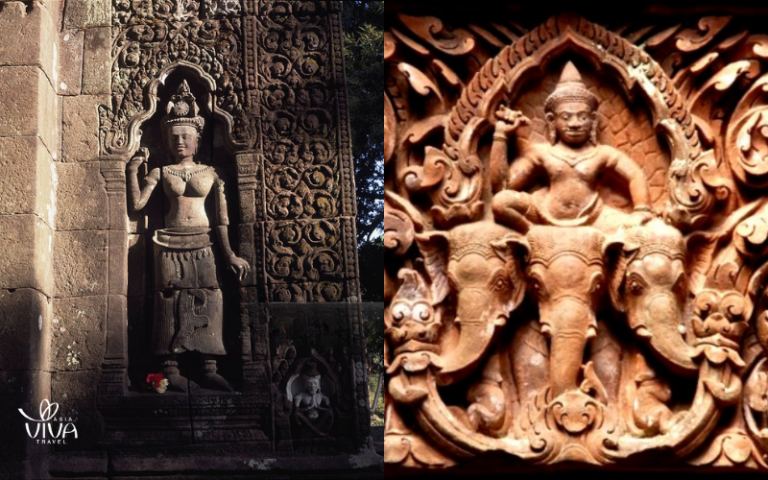
Whispers of Shiva and Vishnu linger in sacred stone
As Theravada Buddhism gradually became the dominant religion in Laos, Wat Phou embraced a new spiritual identity. Rather than erasing its Hindu roots, the site gracefully adapted—Buddhist shrines and statues now coexist among ancient lintels and stone carvings, creating a layered tapestry of belief.
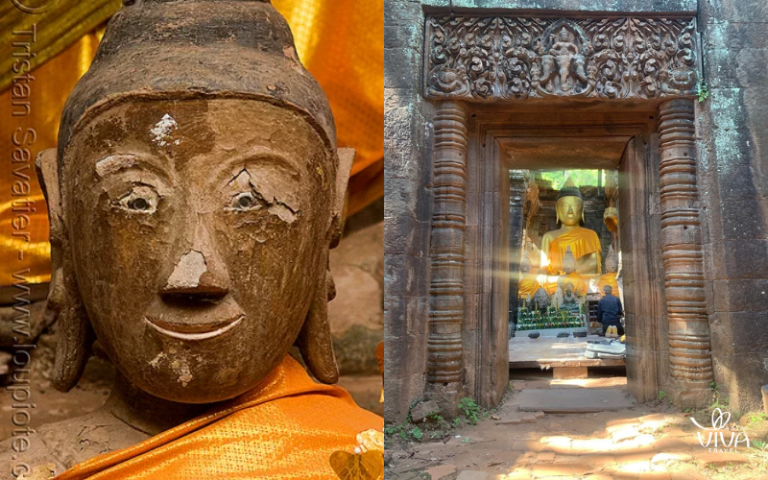
Where Buddha now resides, peace grows through ancient stone
Today, the temple stands as a living testament to the harmonious convergence of Hinduism and Buddhism—a rare and poetic blend. Here, amidst moss-covered walls and timeworn steps, visitors don’t just explore ruins; they witness a sacred conversation carved in stone, echoing across centuries.
Reaching Wat Phu in Champasak is not just a journey, but an invitation to experience the rhythms of southern Laos—where each kilometer reveals rice paddies, riverside villages, and timeless tranquility.
The most common starting point is Pakse, the region’s main hub. From here, the fastest and most flexible option is by private car or motorbike, following Route 13 south for about 30 kilometers (around 45 minutes). At Ban Muang ferry port, travelers cross the Mekong River by local ferry, a short but scenic ride lasting 10–15 minutes. Once on the western bank, it’s another 20-minute drive (roughly 10 km) to Champasak town and the Wat Phu temple site. This route is ideal for independent travelers who enjoy the freedom to stop along the way for photos or roadside snacks.
Alternatively, guided tours from Pakse offer a seamless and informative experience. These often include round-trip transportation, ferry fees, and commentary from local guides who share the legends and spiritual depth of Wat Phu. Tour durations range from half-day to full-day trips, depending on the itinerary, and are a great option for travelers short on time but eager for meaningful context.
For those craving a slower, more immersive approach, consider traveling by boat from Pakse to Champasak. The river journey takes around 1.5 to 2 hours, offering peaceful views of the Mekong and the surrounding countryside. Boats can be arranged through local guesthouses or tour operators, and though the pace is unhurried, the beauty is unforgettable.
Once in Champasak town, visitors staying overnight can also rent bicycles to reach Wat Phu. The ride takes about 20–30 minutes, gliding through tree-lined paths and sleepy villages. Cycling offers a quiet and contemplative route—perfect for travelers who enjoy the soft rhythm of the road.
In essence, getting to Wat Phu is part of its allure. Whether you come by land or water, on two wheels or with a local guide, the journey immerses you in the landscapes and spirit of Laos—setting the tone for a truly sacred and enriching encounter.
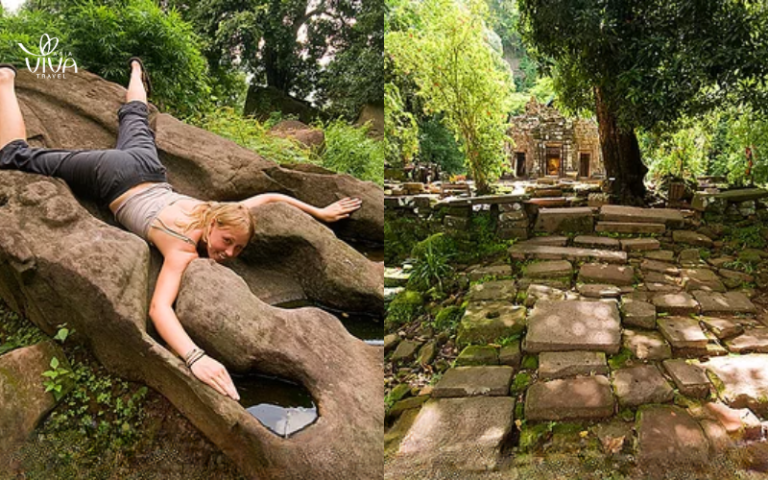
Not just ruins—but revelations carved in time
The best time to visit Wat Phu Champasak temple, Laos is from November to February, when southern Laos enjoys its cool, dry season. During these months, the weather is pleasantly mild with clear skies, making it ideal for exploring the temple grounds, walking up the ancient stone path, and admiring the mountain-backed scenery in comfort.
If visiting during the rainy season (May to October), travelers should be prepared for occasional downpours and slippery paths. However, the lush greenery that blankets the landscape during this time adds a mystical charm to the ruins, with mist rising from the mountains and the temple appearing almost ethereal. While the experience remains beautiful year-round, proper footwear and rain gear are essential for a safe and enjoyable visit outside the dry season.
Wat Phu (Champasak)is not just a destination, it’s a spiritual journey through time, where mythology meets history beneath the shade of sacred trees and stone relics. Whether you’re drawn by ancient architecture, the fusion of spiritual traditions, or the majestic Mekong scenery, Wat Phu promises an unforgettable cultural experience in the heart of Southern Laos.
Let Asia Viva Travel accompany you on this meaningful adventure—with expert local guides, thoughtful itineraries, and seamless service that brings the soul of Laos closer than ever.
Book your journey now and uncover the timeless beauty of Wat Phu with us!

 19/11/2025
19/11/2025The Golden Triangle is one of the most legendary travel destinations in Southeast Asia, known for its history, stunning river landscapes, and multicultural influence

 08/10/2025
08/10/2025Discover Laos airports: 11 international & domestic hubs connecting travelers to Vientiane, Luang Prabang, Pakse, and nearby Southeast Asian countries.

 05/09/2025
05/09/2025Discover the Bolaven Plateau in southern Laos – explore stunning waterfalls, coffee plantations, local markets, and scenic loops with our complete travel guide
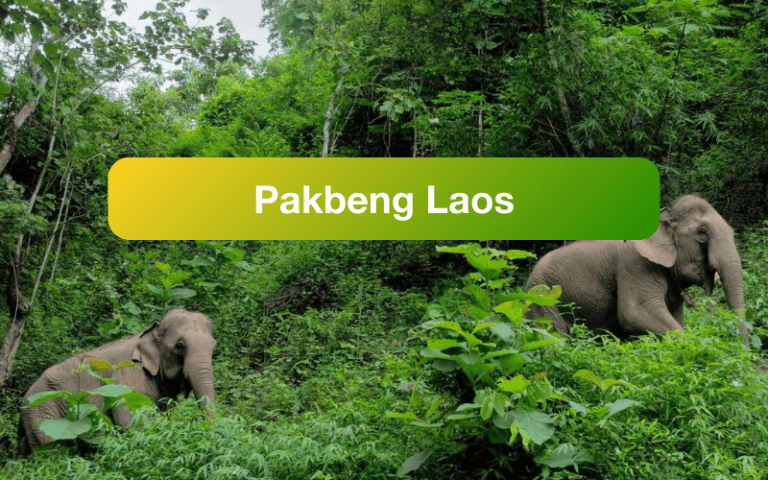
 23/08/2025
23/08/2025A true vagabond experience in the Pakbeng Laos river region, where the pace of life slows down on a slow boat trip, exploring peacefu villages and l landscapes